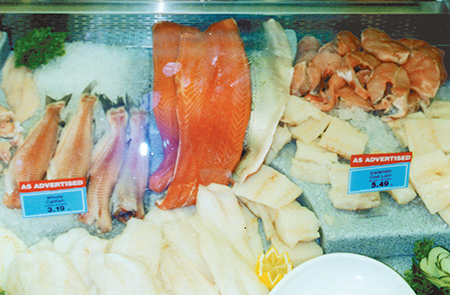Preservation method prevents oxidation of pigments in processed meat and fish

The term “tasteless smoke” (TS) has a mystifying ring to it, but in fact represents a straightforward concept. TS is a highly purified extract of wood smoke in which all the particulate matter has been removed. To put it simply, it is wood smoke with the smoke flavor missing.
With TS, as with unpurified wood smoke, most of the benefit derived from its use is due to the action of carbon monoxide (CO) on the meat surfaces it contacts. TS usually contains the same amount of CO as regular wood smoke. This CO is responsible for the longer shelf life and color-enhancing effects of the treatment.
Effect on flesh
CO is a natural product of combustion that can be used to treat meats without passing on any of the toxic effects that would be associated with breathing it. The CO in TS reacts with muscle pigments on the cut surface of meat or fish and forms carboxymyoglobin, a very stable complex. This complex prevents the oxidation of the myoglobin pigment. By keeping myoglobin oxidation from occurring, processors and marketers can maintain the desired red or white color of meat and fish.
Patented preservation process
TS was patented in the late 1990s as a treatment that “helps preserve the freshness, color, texture, natural flavor, moisture retention, and shelf life of frozen and thawed seafood.” It was originally intended mainly for the preservation of quality and color in sashimi-grade tuna, which can fetch prices 5 to 10 times higher than lobster if the preferred reddish hue is apparent in the fillets. A fillet of tuna can be quite fresh and safe, but lose its value in the sashimi market without the hue.
More recently, processors found that TS has a similar effect on the fat layer of tilapia fillets. It creates a pinkish hue that makes the product more appealing to consumers.
Many benefits
These findings make tasteless smoke very useful to processors and marketers. In a single step, it extends shelf life and improves marketability without changing the flavor of the product. It is especially helpful to use TS in fish that is to be frozen and then thawed before sale or use. Freezing and thawing can have marked effects on the color and texture of fish flesh that create an unsellable appearance, even though the quality of the fish is high.
Potential for abuse
Tasteless smoke treatments have the potential for abuse, however, because they can make substandard products appear better than they are. To trained buyers, fortunately, other aspects of a sensory evaluation (moisture level, odor, and overall appearance of a less-than-fresh product) should overrule the initial appeal of bright color.
FDA-approved
When properly used, TS is a process approved by the U.S. Food and Drug Administration (FDA) Still, the FDA believes that TS or CO processes might be abused to make lower grades look better or mask decomposition. Where CO concentration is too high or meat is treated for a protracted period, the color can remain fixed even after decomposition begins.
Proper labeling
To address this potential problem, FDA has stipulated that TS-treated seafood must be accurately labeled and appear near normal in flesh color. Products that do not meet this standard can be deemed economically adulterated under Section 402 (b)(4) of the Federal Food, Drug, and Cosmetic Act.
Conclusion
Tasteless smoke is a relatively new technology that prevents oxidation of pigments in processed meat and fish. TS extends shelf life and improves marketability without changing product flavor. In uses approved for seafood processing, TS is particularly important for fish that is to be frozen and then thawed before sale or use.
(Editor’s Note: This article was originally published in the April 2002 print edition of the Global Aquaculture Advocate.)
Now that you've finished reading the article ...
… we hope you’ll consider supporting our mission to document the evolution of the global aquaculture industry and share our vast network of contributors’ expansive knowledge every week.
By becoming a Global Seafood Alliance member, you’re ensuring that all of the pre-competitive work we do through member benefits, resources and events can continue. Individual membership costs just $50 a year. GSA individual and corporate members receive complimentary access to a series of GOAL virtual events beginning in April. Join now.
Not a GSA member? Join us.
Author
-

George J. Flick, Jr., Ph.D.
Food Science and Technology Department
Virginia Tech (0418)
Blacksburg, Virginia 24061 USA[117,100,101,46,116,118,64,103,107,99,105,108,102]
Tagged With
Related Posts

Intelligence
Fat content, freezing affect cold-smoked salmon quality
Product quality in cold-smoked salmon is best maintained by smoking fresh fish with high fat content and freezing them after, not before, smoking.

Intelligence
All about Listeria
The pathogenic bacterium Listeria monocytogenes is present in the environment and easily transferred to food and food contact surfaces.

Intelligence
For healthy eating, we are what we allow
Many current eating habits have negative results for our health, lending credence to “you are what you eat.” Eating habits can be changed, and increasing seafood consumption can provide numerous health benefits, including as a significant source of critical micro-nutrients, vitamins and minerals. Seafood should have its own spot in our dietary food pyramid.

Intelligence
From the Hollywood Hills to the raceways of Riverence
Six-year-old Riverence Holdings, founded by a cattle rancher and a Hollywood TV producer, is now the largest land-based trout producer in the Americas.

